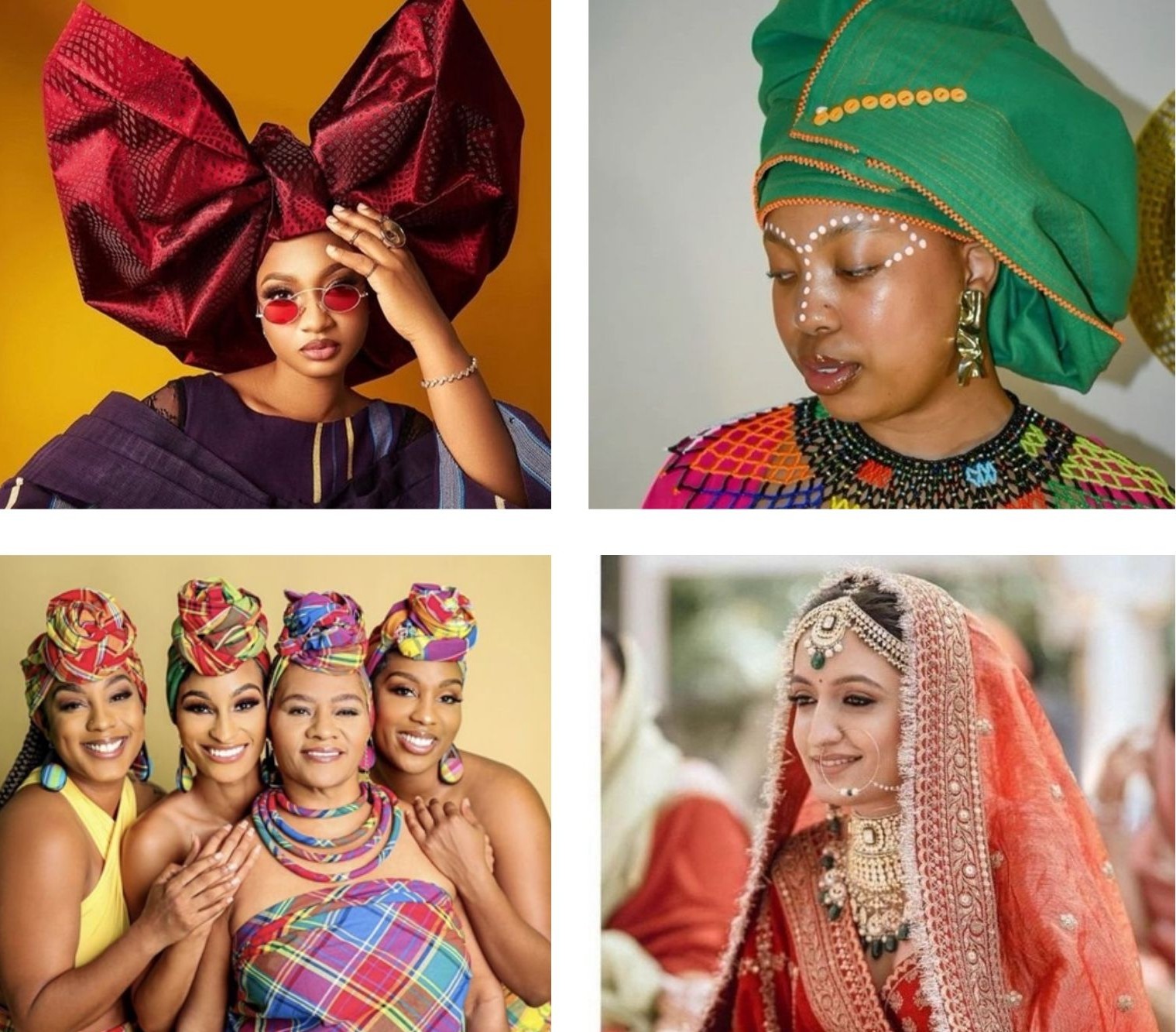By Sipho Khumalo
There’s something magnetic about a woman in a headwrap. She enters the room, fabric folded just so, colors clashing or blending in ways you never imagined, and suddenly her presence feels taller. A headwrap isn’t just a piece of cloth, it’s a crown, a story, a wink at history, and sometimes, a bold fashion mic drop. Across the world, women have been tying, wrapping, and twisting fabric around their heads for centuries, each fold carrying more meaning than outsiders often realize. What looks like “just style” is, more often than not, language.
Nigeria: The Gele That Speaks Before You Do
Let’s start in Nigeria, home of the gele. If you’ve ever attended a Nigerian wedding, you already know, geles aren’t quiet accessories. They’re statement pieces. Bold, stiff, often metallic, sometimes tall enough to brush a door frame. A gele announces your arrival before you even say hello. And it’s not just fashion; it’s status. A well-tied gele can say, I’ve got taste, I’ve got class, and yes, I spent hours perfecting this bow that’s currently defying gravity.
But beyond the flair, the gele carries cultural pride. It’s tied during ceremonies, parties, and festive occasions, moments where women take center stage. And no two geles are ever exactly alike. Each fold becomes a fingerprint.
South Africa: The Doek as Everyday Power
Travel south and you’ll find the doek, a staple in South Africa. Unlike the gele’s party-girl energy, the doek can be quiet but just as powerful. Women wear it for church, family gatherings, or simply as an everyday sign of dignity. Historically, during apartheid, Black South African women wore doeks as both necessity and resistance protecting hair from harsh conditions while asserting cultural identity in a system that tried to erase it.
Today, the doek has been embraced by younger generations who wrap it in funky prints or tie it high and dramatic. It’s the same cloth, but the messaging has shifted: We’re still here. We’re still bold. And we look amazing while doing it.
The Caribbean: Tignon Laws and Rebellion in Style
Hop across the Atlantic to the Caribbean and Louisiana, where the headwrap once became a political flashpoint. In the late 18th century, colonial authorities enforced tignon laws, ordering women of African descent to cover their hair. The intent was to mark them as “lesser” and curb the attention they received from men of European descent. But here’s where culture does its magic, women didn’t shrink under those laws. Instead, they wrapped their hair in elaborate, colorful fabrics that turned the supposed badge of inferiority into a crown of pride.
Centuries later, the tignon remains part of cultural memory. What started as oppression flipped into resistance, then settled into fashion. Women wore the cloth and said, Fine, I’ll cover my hair. But I’ll do it better than you expected.
India: Dupattas, Chunnis, and Graceful Covers
In South Asia, the dupatta or chunni often flows from a woman’s head as part of traditional dress. Unlike the stiff folds of the gele, the dupatta whispers elegance. Draped over the head at weddings, temple visits, or festivals, it frames the face in softness. It carries respect, modesty, and cultural continuity, but also playfulness. Bollywood films turned the dupatta into an accessory of flirtation, with heroines using it to tease, cover, or beckon.
Here, fabric isn’t just covering; it’s choreography.
The Hijab and Global Conversations
Of course, no conversation on headwraps is complete without the hijab, worn by millions of Muslim women across the globe. The hijab isn’t a monolith, styles shift from Istanbul to Jakarta, Cairo to London. It can be black and minimal, floral and flowing, or tucked neatly like modern streetwear. For many, it’s faith; for others, it’s cultural identity; for some, it’s both.
The global hijab conversation often gets flattened into politics, but listen to women themselves and you’ll hear stories of pride, creativity, and even entrepreneurship. Entire industries have risen around hijab fashion, with influencers styling them as boldly as any runway look.
Wrapping It All Together
What’s striking is how universal headwrap traditions are. Whether it’s a gele in Lagos, a doek in Cape Town, a tignon in New Orleans, a dupatta in Delhi, or a hijab in Dubai, women everywhere have reached for fabric and turned it into art. Sometimes it’s a shield, sometimes it’s rebellion, sometimes it’s just “because I felt fabulous today.”
Headwraps remind us that culture isn’t static, it folds, twists, and ties itself into new meanings over time. A grandmother’s scarf becomes a granddaughter’s Instagram-ready look. What was once seen as humble or restrictive becomes powerful and stylish.
And maybe that’s the real crown, this ability women have to take cloth, ordinary cloth, and transform it into something extraordinary. Something that carries history on one end and possibility on the other.
So the next time you see a woman in a headwrap, know this: you’re not just looking at fabric. You’re looking at centuries of creativity, and joy balanced perfectly on her head.







